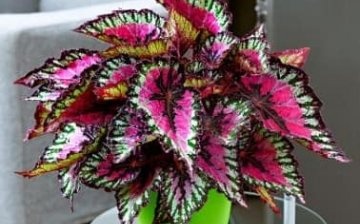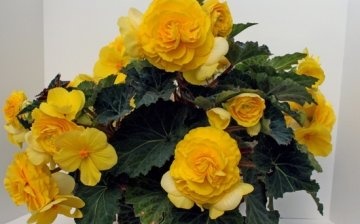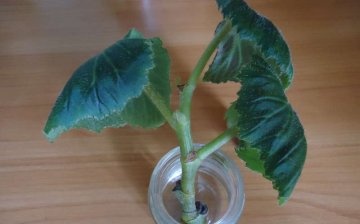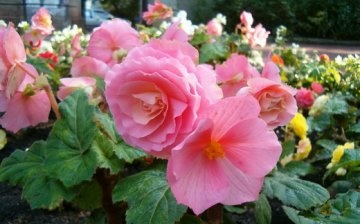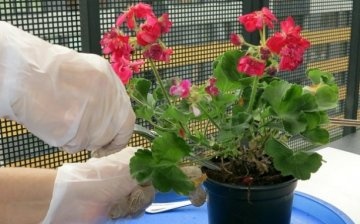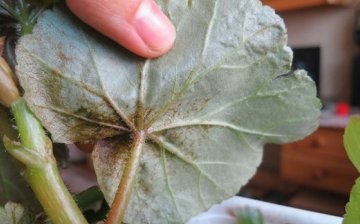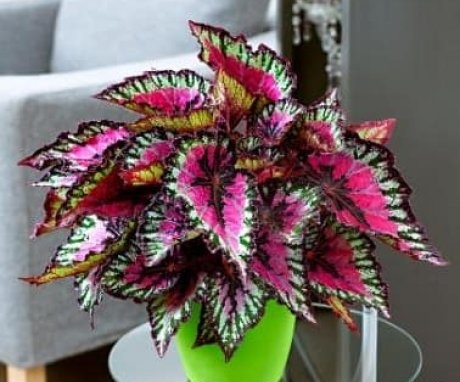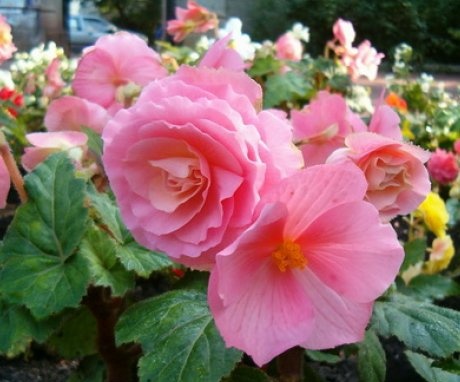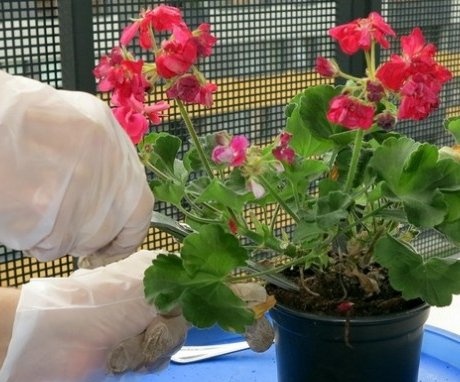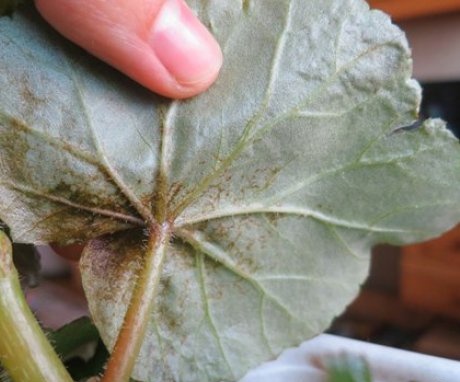Popular types of begonias and the rules for their cultivation
Among florists, it is especially popular begonia, which has been grown both indoors and outdoors for more than two hundred years. The homeland of this wonderful plant is the tropical forests of Asia, America, from where it was brought by French travelers.
The tropical plant begonia is striking in its variety of species and forms, which are placed in two groups of decorative deciduous and flowering flowers. The first group is characterized by forms from ampelous and bushy to tall. All of them are interesting for their amazingly shaped leaves with bright colors, patterns, and small nondescript inflorescences. Attention is drawn to the begonias of the blooming group because of the beautiful bright flowers strewn with lush bushes.
Content:
- Features of the main types of begonias
- Creating conditions for growing a flower
- Plant propagation methods
- Planting begonias: rules and terms
- Ornamental Plant Care Tips
- About diseases and pests of begonia: how to avoid them
Features of the main types of begonias
Plants that are distinguished by the beauty of the leaves include the following types:
- Royal begonia can be found in almost all gardeners. She is loved for the large leaves of an asymmetrical shape, which are painted with bright patterns using pink, purple, silver, brown, green paint.
- Have Mason's begonias the leaves look like the shriveled skin of a bright green lizard with brown lines extending from the center.
- The coral begonia, which is two meters tall, has silver leaves, and it got its name from the color of its small flowers.
- Slightly shorter than it in length, the begonia is metallic with small leaves on top of an olive green color, and below it is dark red.
- Striped begonias and dotted begonias have a pattern corresponding to the name on dark green leaves.
The group of begonias with beautiful flowers includes several species bred by breeders:
- In indoor crops, tuberous is distinguished with bright colors of different tones. These species can also grow in the garden, decorating flower beds, in the summer.
- Ampel species of hanging begonias are used in hanging baskets, pots.
Many varieties of flowering begonias delight with bright inflorescences all year round. For example, bushes of an ever-flowering species with small flowers of red, white shades will decorate the lawns near the house in summer, and then continue to bloom in the boxes of the house. Today there are about a thousand plant species, and thousands of hybrids have been bred by breeders.
Creating conditions for growing a flower
The birthplace of begonias is tropics, subtropics, therefore, the conditions for its growth must be appropriate for these climatic zones. It is more comfortable for all types of plants to grow in bright places, with a little shade. The scorching rays of the sun can damage the leaves and burn them. A good place for a pot with begonia there will be a window sill on the east or west side. In colder months, the flower will require additional lighting.
The average temperature is considered in the period of spring, summer, about 20 degrees Celsius, and in winter - at least 18.
You can create high humidity by placing a container with a plant in a tray with moss or pebbles constantly soaked in moisture. The water will evaporate, leaving the air humid around the begonias. Begonias blooming all year round are taken out into the garden in the warm season, where they can withstand temperatures up to plus thirteen, bringing them indoors for the winter. The tubers of plants dying off during the winter are dug up and stored in basements at a temperature of at least five degrees Celsius.
The soil for flowers must be rich organic, for which the garden soil is mixed with peat or rotted manure, adding a little river sand. Many types of plants rest in winter, so at this time the aboveground part is cut off so that the flower fully recovers after the dormant season. Another main point of growing an ornamental bush is its unwillingness to share the territory of a window sill or flower bed with other plants. Begonia does not like touch, reacts to it painfully. If the plant has enough warmth, humidity, then it will settle in the house for a long time.
Plant propagation methods
There are several methods of flower propagation, each has positive and negative sides, suitable for a certain type of begonia.
- The plant is often propagated by a leaf, which is cut along with the cuttings. Then, after making transverse cuts on the veins, lay the leaf on moistened soil and press with small pebbles. The container covered with a film is placed in a warm place with sufficient lighting. Within a month, until the children appear, it is necessary to ventilate, spray the soil with a leaf. You can root it in a container with water, in which the drug Kornevin is dissolved, several tablets of activated carbon. When the roots appear, the petiole is transplanted into a pot. Leaf propagation is used for winter begonias, Mason flowers, and creeping stem plants.
- By cuttings bush varieties are propagated, and for this the stalk must have at least two buds. It is slightly dried before planting, and then placed in previously prepared containers with soil. Creating a greenhouse effect will help the cuttings closed with a jar quickly take root. The timing depends on the type of plant, the condition of the sprout. During this time, daily airing of the material is mandatory.
- Tuberous plant species are propagated by dividing the bush... Dig up the begonia, thoroughly wash the root part. After that, they begin to cut the tuber into pieces with the kidney on them. After drying and processing the cut area with activated carbon, they are planted in the prepared soil, thoroughly moistening it. From above, the containers with tubers are covered with a film and are waiting for the appearance of leaves, rooting. After that, you can plant the seedlings in different pots. Non-tuberous plant species are propagated in a similar way by cutting the rhizome into pieces.
- Seeds the plant is planted in the middle of winter, distributing them over the prepared soil. The crops covered with film are kept in rooms with a high air temperature of at least 25 degrees above zero. Watering and airing the plantings should be daily. After two weeks, you can enjoy the first shoots. Dive produced after the appearance of the first two leaves.
All breeding methods are actively used by flower growers, but many prefer vegetative ones due to their speed and high efficiency. But the seed method helps to preserve the varietal characteristics of the flower.
Planting begonias: rules and terms
Each type of begonia has different planting dates. The ideal time is considered the first month of summer, when the sun has little activity, and the air has already warmed up to high levels. Since the flower does not tolerate sudden changes in temperature, it is better to cover the plantings with foil on cold nights.
The tuberous type of begonia is planted in March, having prepared a box with a sandy substrate, having moistened it in advance.
It is not recommended to bury the tubers deeply; they are simply buried a little into the ground. The boxes should be in a warm place with dim lighting. As soon as sprouts appear and reach a height of one and a half centimeters, the tubers are placed in individual containers, placing them on the surface of the earth. You can place them in open ground after the buds appear.
The distance between plants in the garden should be about twenty centimeters. The main requirement is soil moisture without stagnant water. To protect the sprouts from burns, they are covered with paper. Compliance with the rules of planting a plant can help breed different varieties of a decorative flower.
Ornamental Plant Care Tips
A tropical perennial does not require special care, only a few rules must be followed:
- Begonia needs constant watering, but you cannot overdo it either: it does not tolerate stagnant water. During the dormant period, the number of waterings should be kept to a minimum.
- Introduction top dressing occurs actively when the plant is in bloom. At this time, fertilize every week with a weak solution of potassium nitrate, phosphates. But it is better not to get carried away with nitrogenous fertilizers.
- It is necessary to cut off wilted inflorescences constantly. This will lengthen the time flowering plants. Before the flower enters the dormant period, which usually lasts from November to March, the entire ground part of the begonia is removed.
- Transplant the plant is needed once every three years, which will allow it to renew itself, starting a new period of life.
Begonia can be seen not only at home, but also in offices, it looks great, giving them not only style, but also sharing health with people, increasing their mental qualities and efficiency.
About diseases and pests of begonia: how to avoid them
During the period of vital activity, the plant can become infected with various fungal diseases. When white spots appear on the leaves, this is a symptom of gray rot, and brown, brown spots are bacterial spots. Fungal diseases can be cured fungicidal preparations (Fundazol solution), and there is no effective treatment against bacterial infection - you will have to part with the plant.
Of the pests attacking begonia, it can be noted aphids, nematodes, thrips, whitefly:
- More than two hundred species of whitefly live in nature, and it is already attacking indoor plants. The insect resembles a small moth with white, floury wings. The pest multiplies quickly, laying more than one and a half hundred eggs on the leaves per month. Touching the sheet begonias, you can see how the moths fly in different directions. The affected parts of the flower are covered with spots, waxy bloom. Parasites suck out the juices of the plant, it begins to weaken and may die. He will be saved only by removing diseased areas, treating the leaves with a solution of laundry soap or spraying with drugs such as Aktara.
- Microscopic insects with an elongated body, thrips with a sharp proboscis drink juice from parts of plants, making them openwork, covered with a dry net. Carrying viral diseases, thrips infect indoor flowers, and they die. You can free begonia from it by carefully examining each leaf, washing the infected areas under running water, and removing dry parts of the plant, including flowers. The begonias damaged by the parasite must be transplanted into other containers, then treated with insecticidal preparations.
- Aphids are also fought with either chemical or biological agents. Aphids are dangerous as a carrier of viral infections, which usually kills the plant.
- Nematodes damage the root part of the begonia, growths and swellings appear on it. A solution of Formalin or Tiazon will save the flower.
Taking care of your flower, you can prevent the appearance of various ailments, the attack of pests. Known to many begonia serves not only to decorate rooms, but it gives a person strength, health, and has a positive effect on his mental abilities.The article tells about how to breed this plant, what methods to propagate, how to make it hardy and healthy.
More information can be found in the video:




